Contents
- Introduction
- What is A/B testing?
- What is the point of A/B testing?
- What can you A/B test?
- Tools for A/B testing
- How to plan for an A/B test
- How to perform an A/B test in Google Ads
- How to A/B test your landing pages
- Conclusion
You’ve written all of your ads, researched and filled out your ad groups and launched your campaigns in Google Ads, great! But what will you do when your ads start to become stagnant and your key performance indicators (KPIs) hit a plateau? Hope for the best? Add more keywords? Nope. Your best bet is to perform some A/B testing for your Google Ads campaign.
What is A/B testing?
You may have heard about A/B testing before, it is sometimes referred to as split or bucket testing. A/B testing involves testing a statistical hypothesis through an experiment using two similar samples of data that usually have a key variable. If your statistical hypothesis is proven correct through A/B testing, you can optimise key performance indicators by carrying out variable changes from your A/B test, almost like a science experiment!
For example, if you had a landing page for “SEO Birmingham” you could create a variant of the original landing page for “SEO Birmingham” and choose a variable to measure. A variable could be something as simple as the change of a heading or the positioning of a CTA. You could then test to see if your variable change has positively affected a KPI such as conversions. If so, you implement the change and continue to test.
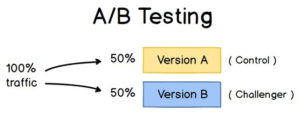
What is the point of A/B testing?
A/B testing is used to diagnose and optimise experiences and KPIs through two similar experiences. It allows the A/B tester to optimise and change a bunch of different factors that are reliably driven by data. A/B testing can be used for an array of different experiments, which is not limited to Google Ads.
Some benefits of A/B testing include:
- Reduced bounce rates – testing landing pages can help you find your best formula for keeping users on your site, whilst providing you with improved content and user engagement.
- Increased conversions – when used to optimise conversions, A/B testing can really pull through. Testing specific sales-orientated variables can lead to a much higher conversion rate, which can also contribute to more sales in the long run.
- Easy analysis – once you have defined your goals and variables, it can be incredibly simple to analyse and compare results. This boils down to the fact that you are comparing just two pieces of data and you know what you’re looking for. It seems simple but it’s extremely powerful.
- Low risk – there is not a lot at stake when A/B testing, as everything will come across as native and natural to the user. Financially, A/B testing can be done cost-effectively with the right tools and know-how.
What can you A/B test?
You can A/B test a vast variety of variables. Prime examples of what you may A/B test in general are:
- Call to action placement and text
- Website copy and headings
- Positioning of a certain on-page element i.e. a contact form
- Marketing funnels
- Visual media, colours, and imagery
- Site navigation
- Pricing of products and services
- Personalisation
- Emails
- Typography (font types & sizes)
- Advertisements
If you wanted to A/B test for Google Ads, your variables are a bit more limited but just as powerful. These A/B variables include:
- Ad copy – this includes headlines, descriptions, final URLs, and URL display paths.
- Ad extensions – including sitelinks, callouts, and structured snippets.
- Ad group variation – you can tweak your bidding strategy, targeted keywords, and keyword types.
- Landing pages – test the effectiveness of various landing pages and see which one may be more effective.
- Negative keywords – check out if tightening up keywords you don’t want to appear for improves vital KPIs.
- Ad scheduling – maybe your ads would benefit from running only on weekdays or between specific hours of the day.
- Location targeting – a great feature of Google Ads is that you can target locations as specific as a postcode. Test out different geographical targeting zones to see which areas give you the best performance.
- Device bids – maybe your ads are better suited to PC users rather than mobile or tablet. Regardless, it’s a good way to find out what device works best for your ads.
Tools for A/B testing
There are loads of A/B testing tools available online. The most reliable ones are mainly Google official products such as Google Optimize, Google Analytics and Google Ads (if you’re planning to A/B test in Google Ads). However, alternative A/B testing software does exist. Here are some of the most popular A/B testing alternatives:
- Optimizely – an enterprise digital experience platform
- VWO – a cheaper yet just as effective alternative
- Zoho Pagesense – a great tool for extensive personalisation
- Convert Experiences – a highly rated A/B testing tool
- Hubspot – a powerful all-in-one tool
- Evolv – suitable for large businesses
- Adobe Target – an established and reliable software brand
How to plan for an A/B test
So, you’re ready to set up an A/B test using Google Ads for the first time… or are you? It’s pivotal that you have a plan before you put any A/B tests in place. It doesn’t have to be some over-the-top, highly detailed plan – just some basic direction and objectives that can help you get started.
You should think about the following before carrying out an A/B test:
- Your variable – what element(s) will you change on your version B?
- Goals – what are you hoping to achieve from your A/B tests?
- Sample size – do you only want to test a certain number of users or would you prefer your A/B traffic to be unlimited?
- Hypothesis – like a science experiment, you need a hypothesis to clarify the direction of your tests.
- Duration – do you want your A/B test to run for a week? A month? Maybe half a year? The choice is yours, but define this duration before starting for greater clarity.
How to perform an A/B test in Google Ads
Now that you are ready to roll out your A/B test in Google Ads, let’s walk through an example.
Step #1: When signed in to Google Ads, look at your taskbar on the left and find the “Show more” tab. Scroll down once expanded until you see “Drafts & experiments” and proceed to “Campaign drafts”. Having a campaign draft is important as you will not be able to A/B test without it.


Step #2: Once your campaign draft is complete, navigate over to campaign experiments.

Step #3: Click the big, blue “+” near the top of the page.

Step #4: Select your desired draft campaign and it will appear underneath. Be sure to name your experiment with a name that doesn’t share the same name as campaigns or other experiments.
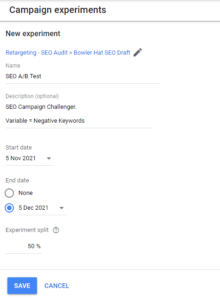
Step #5: Choose your start and end date for your experiment (if you want to manually end your campaign then select the “none” option).
Step #6: If you want to carry out a typical A/B test, then be sure to keep the experiment split at 50% in order to ensure you are running a fair test.
Step #7: Once you’ve done all of the above, you’re ready to save your campaign experiment and make it live.
It is worth noting that there are some advanced settings for search campaign experiments in Google Ads. From here, you are able to decide if you want to count searches or users through a “cookie-based” or “search-based” split. Google defines these as the following:
- Cookie-based means users may see only one version of your campaign, regardless of how many times they search. This can help ensure that other factors don’t impact your results, and may give you more accurate data.
- Search-based lets you randomly assign users to either your experiment or original campaign every time a search occurs. You may get statistically significant results faster than a cookie-based split. It is possible that the same user could see both the experiment and your original campaign if they search multiple times.
How to perform an A/B test for your landing pages
Let’s not forget that with A/B testing, you can also A/B test your landing pages. This works hand-in-hand with Google Ads as a good or bad landing page experience can drastically affect key performance indicators such as conversion and bounce rates.
If you would like to A/B test for a Google Ads landing page, then follow this step-by-step tutorial on how to A/B test a page using Google Optimize.
Step #1: Assuming you have Google Optimize set up and linked to your website – click the “create account” button on the top right of the home page.

Step #2: Select your country and proceed to the “Add Container” tab. Here you will paste your website’s web address (be sure to include www. But not HTTPS or trailing slash). After this, you are all clear to hit that “Create” button.
Step #3: Now you need to create an experience. There should be a big box that says “Let’s Go”, click this to be taken to the “Create Experience” tab. Here you will name your experiment, insert the target A/B test page URL, and select “A/B test” as a type of experience.
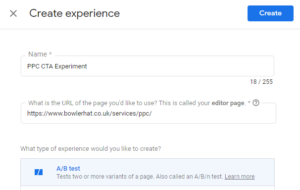
Step #4: Once you have created your experience, you will be taken to your variant page. This is where you will be able to create your A/B test in detail. To get started, select the “Add variant” button.

Step #5: Name and add your variant to the experiment. It’s important to keep the weight at 50% if you plan on running a fair A/B test.

Step #6: Select the blue “Edit” button on the new variant. Here it will take you to the page on your website that you specified.

Step #7: When you have entered the web page, you will see an editor box pop up on your screen. This will allow you to adjust any element on your web page, including colours, positioning, font, size, padding, etc. Make your changes and save the page at once.
REMEMBER: Do not get too carried away with variant changes when running an A/B test, as too many variants can create a convoluted and unclear set of results.
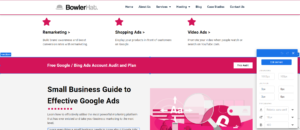
Step #8: Once the variant page has been edited and saved, you will be sent back to your variant creation page. From here, link your Google Analytics account and select an objective (conversion you want to track) that you will measure.
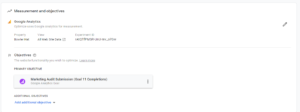
Step #9: Make your experiment live, sit back, and relax. The experiment will run until paused or terminated, so you can leave the experiment to run for whatever time period you want. Once an adequate amount of time has passed, review the experiment and see if your test was successful. If so, you can easily implement the changes from your A/B test with the click of a button.
A/B Testing for Google Ads – Conclusion
A/B testing to optimise your PPC/Google Ads accounts is pivotal in achieving higher conversion rates, which we know will lead to more sales – so it’s important to not overlook A/B testing when running your own campaigns.
Additionally, A/B tests are relatively easy to set up and very cost-effective when done correctly. It can lead to increased engagement, reduced bounce rates, improved web pages, and much more. The opportunities are virtually endless and the chance for refining your campaigns or website will be ever-present, you just need to find it!
If you require some help with your PPC campaigns or running A/B tests, get in contact with Bowler Hat here or give us a call on 0121 315 2001.







7 Responses
This helped out loads!
Good Blog, Keep Posting this type of content
Very useful post!
Thank you for sharing this information. It’s really helpful to me.
Glad I could help 🙂
Nice stuff
Thank you for sharing this information!